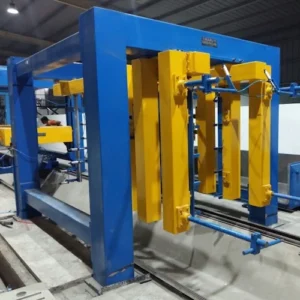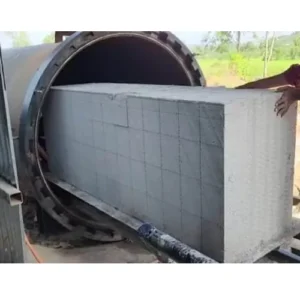Subtotal: ₹2,710,000.00
AAC Block Making Machine
-
AAC Blocks Making Machine
Method Autoclave AeratedCapacity 30-750 cumWarranty 1 Year₹25,000,000.00AAC Blocks Making Machine
₹25,000,000.00 -
Mild Steel Fully Automatic AAC Block Making Machine
Brand CKSCapacity 8600 Per DayBlock Type Light Weight₹34,500,000.00Mild Steel Fully Automatic AAC Block Making Machine
₹34,500,000.00 -
AAC Block Making Plant, Automatic
Automation Grade AutomaticBrick Material Quick LimeProduction Capacity 50,000-350,000 blocks per day₹7,500,000.00AAC Block Making Plant, Automatic
₹7,500,000.00 -
Fully Automatic Aac Block Making Plant
Brand BuildmateI deal in New OnlyBlock Type AAC₹98,000,000.00Fully Automatic Aac Block Making Plant
₹98,000,000.00
AAC Block Making Machine: A Complete Guide to Efficient Manufacturing of Autoclaved Aerated Concrete Blocks
Introduction to AAC Block Making Machines
What is an AAC Block Making Machine?
An AAC Block Making Machine is a specialized piece of equipment used in the production of Autoclaved Aerated Concrete (AAC) blocks, which are lightweight, durable, and energy-efficient building materials. AAC blocks are made by combining a mixture of cement, lime, sand, water, and an aerating agent (such as aluminum powder) in a specific ratio. The mixture is poured into molds, where it undergoes chemical reactions and hardens to form lightweight yet strong blocks. These blocks are then subjected to high-pressure steam curing (autoclaving) in an autoclave, which enhances their strength and thermal insulation properties.
AAC blocks have gained popularity in the construction industry due to their eco-friendly nature, superior insulating properties, and ease of use. The demand for AAC block production is growing, and AAC block making machines are at the core of this expanding industry.
Benefits of AAC Block Making Machines
-
High Production Efficiency: AAC block making machines are designed for large-scale production, with some high-capacity machines capable of producing thousands of blocks daily. This leads to improved operational efficiency and higher production volumes, making them suitable for large construction projects.
-
Lightweight yet Strong: The primary advantage of AAC blocks is their light weight compared to traditional concrete blocks. The aerated nature of the blocks allows them to be handled easily during construction, reducing transportation and labor costs. Despite being lightweight, AAC blocks are durable and have excellent compressive strength, making them suitable for load-bearing walls.
-
Thermal Insulation and Energy Efficiency: AAC blocks are known for their superior thermal insulation properties. They provide a natural barrier against heat, making them ideal for buildings in regions with extreme temperatures. The blocks help reduce the need for additional insulation materials, leading to energy savings for the building occupants.
-
Fire Resistance: AAC blocks have a high resistance to fire, which adds to the overall safety of buildings constructed with them. The blocks are non-combustible and can withstand high temperatures, making them a safe choice for fire-resistant construction.
-
Sustainability and Eco-Friendliness: AAC blocks are made from natural raw materials such as lime, cement, sand, and water, and the production process uses minimal energy. The blocks are also recyclable, contributing to sustainable construction practices. The use of AAC blocks can reduce the overall carbon footprint of buildings and construction projects.
-
Sound Insulation: The porous structure of AAC blocks provides excellent sound insulation, making them a good choice for buildings located in noisy environments or multi-unit dwellings, such as apartments and hotels.
-
Ease of Handling and Construction: AAC blocks are easier to handle due to their lightweight nature, which also reduces the time and cost associated with transportation and handling during construction.
How Does an AAC Block Making Machine Work?
The Manufacturing Process
The manufacturing process of AAC blocks involves several key steps, all of which are performed by the AAC block making machine. Here’s a breakdown of the process:
-
Preparation of Raw Materials: The process begins with the preparation of raw materials, which include cement, lime, sand, water, and an aerating agent (usually aluminum powder). These materials are mixed in specific ratios to create a homogeneous mixture.
-
Mixing: The raw materials are loaded into a mixer, where they are combined with water to create a slurry. The aerating agent, often aluminum powder, reacts with the lime and cement to create tiny air bubbles, which give the blocks their lightweight, aerated structure.
-
Pouring into Molds: Once the mixture reaches the desired consistency, it is poured into molds of various sizes. The molds can be customized to produce blocks of different dimensions, depending on the project requirements. The blocks are left to rise and cure for a specific period, during which they expand and form the desired cellular structure.
-
Cutting: After the mixture has set and hardened in the molds, the large blocks are removed and transferred to a cutting area. A cutting machine, typically equipped with a set of wires or saws, slices the large mass into individual AAC blocks of the required sizes and shapes. The cutting process is highly precise, ensuring that each block meets the necessary dimensions and tolerances.
-
Autoclaving: The cut blocks are then subjected to autoclaving, a high-pressure steam curing process. The blocks are placed in an autoclave, where they are exposed to steam at high temperatures (usually 180–200°C) and pressure. This process enhances the chemical reaction, making the blocks stronger, more durable, and giving them their fire-resistant properties. Autoclaving also accelerates the curing process, allowing the blocks to achieve their full strength in a short amount of time.
-
Final Inspection and Packaging: After autoclaving, the AAC blocks are removed from the autoclave and undergo a final inspection to ensure quality. The blocks are checked for size, density, and strength before being packaged for shipment. They are stacked on pallets, ready for delivery to construction sites or distribution centers.
Key Components of an AAC Block Making Machine
-
Mixer: The mixer is responsible for combining raw materials, including cement, lime, sand, water, and aluminum powder, into a consistent slurry. The quality of the mix directly affects the quality of the final AAC blocks.
-
Molding System: The molding system consists of a set of molds into which the slurry is poured to form large blocks. These molds are designed to allow for the expansion of the mixture, giving the blocks their aerated structure.
-
Cutting Machine: The cutting machine slices the large AAC blocks into smaller, standardized sizes. The machine uses a series of wires or saws to make precise cuts based on the required block dimensions.
-
Autoclave: The autoclave is a high-pressure steam chamber that cures the AAC blocks at elevated temperatures and pressures. This step is crucial for the development of the block’s strength and fire-resistant properties.
-
Control Panel: The control panel allows operators to monitor and adjust various parameters of the AAC block production process, including the mixing ratio, curing temperature, and pressure inside the autoclave.
-
Packaging System: Once the blocks are cured and ready for shipment, they are transferred to the packaging system, where they are stacked, wrapped, and prepared for delivery.
Advantages of Using an AAC Block Making Machine
-
High Productivity and Low Labor Costs: The automation of the AAC block production process ensures high levels of productivity with minimal human labor. The efficiency of the machine reduces the need for a large workforce, resulting in cost savings on labor.
-
Customization and Flexibility: AAC block making machines can produce blocks of different sizes and shapes, allowing for greater flexibility in meeting project requirements. Custom molds can be used to produce specialized blocks for specific applications.
-
Precision and Consistency: The use of cutting-edge technology in AAC block making machines ensures that each block is produced with precise dimensions and consistent quality. This minimizes defects and improves the overall performance of the building material.
-
Energy Efficiency: Modern AAC block making machines are designed with energy efficiency in mind. The autoclaving process uses less energy compared to traditional brick-making methods, which helps reduce operational costs.
-
Low Maintenance Requirements: AAC block making machines are designed to be durable and require minimal maintenance. With proper care, these machines can operate for years without significant downtime.
-
Environmentally Friendly Production: The production of AAC blocks uses less water and energy compared to traditional concrete or clay blocks. Additionally, AAC blocks are made from natural raw materials and are fully recyclable, making them an eco-friendly building material.
Applications of AAC Blocks
-
Residential Construction: AAC blocks are widely used in the construction of homes, villas, and residential complexes. The lightweight nature of the blocks makes them easy to handle, and their superior insulating properties contribute to energy-efficient homes.
-
Commercial Buildings: AAC blocks are increasingly used in the construction of office buildings, shopping malls, and other commercial properties. Their soundproofing, fire resistance, and energy efficiency make them ideal for large commercial projects.
-
Industrial Buildings: Due to their high strength, AAC blocks are also used in industrial buildings, including factories, warehouses, and storage facilities.
-
Road Construction: In some regions, AAC blocks are used in road construction to create durable and weather-resistant pavement surfaces. The blocks’ ability to withstand heavy loads and extreme temperatures makes them suitable for such applications.
-
Acoustic Barriers: The excellent sound insulation properties of AAC blocks make them ideal for use in constructing acoustic barriers along highways, railways, and airports, reducing noise pollution.
Market Trends and Innovations in AAC Block Making Machines
-
Automation and Smart Features: Advances in automation and smart technology are making AAC block production more efficient and user-friendly. Manufacturers are increasingly integrating smart features into AAC block making machines, such as remote monitoring and control, predictive maintenance, and real-time performance tracking.
-
Sustainability in Production: There is a growing emphasis on sustainable practices in the construction industry, and AAC block production is no exception. Manufacturers are working to reduce the carbon footprint of the production process by using renewable energy sources, recycling materials, and optimizing resource usage.
-
Customization Options: Modern AAC block making machines offer a higher degree of customization, enabling manufacturers to produce blocks in various sizes, shapes, and densities to meet the unique requirements of different construction projects.
-
Global Demand for AAC Blocks: The demand for AAC blocks is increasing in emerging markets, particularly in regions with rapid urbanization and industrialization. As a result, there is a growing market for AAC block making machines in countries like India, China, the Middle East, and parts of Africa.
Conclusion
AAC block making machines are the backbone of the rapidly growing market for Autoclaved Aerated Concrete blocks. These machines offer unparalleled efficiency, precision, and sustainability in the production of lightweight, durable, and energy-efficient building materials. With their increasing demand in residential, commercial, and industrial construction, AAC block making machines are poised to play a key role in shaping the future of the construction industry.
By investing in high-quality AAC block making machines, manufacturers can improve their production capacity, reduce costs, and meet the growing demand for eco-friendly, energy-efficient building materials. The future of AAC block production looks bright, with advancements in automation, sustainability, and customization driving innovation and market growth.







